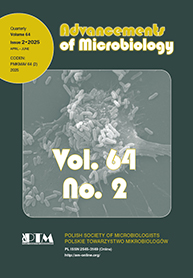Streszczenie: Rodzaj Alicyclobacillus obejmuje Gram-dodatnie, Gram-ujemne i Gram-zmienne, acydotermofilne bakterie przetrwalnikujące, izolowane z różnych środowisk, głównie z gleb kwasowych i geotermalnych, gorących źródeł, powierzchni owoców i zepsutych soków owocowych. Bakterie należące do rodzaju Alicyclobacillus charakteryzuje obecność ω-alicyklicznych kwasów tłuszczowych (ω-cykloheksylowych i ω-cykloheptylowych), izo- i anteizo-rozgałęzionych kwasów tłuszczowych oraz hopanoidów zlokalizowanych w błonach plazmatycznych. Dotychczas zidentyfikowano 23 gatunki oraz dwa podgatunki, wśród których najbardziej rozpowszechniony jest Alicyclobacillus acidoterrestris. Niektóre gatunki stanowią zanieczyszczenia mikrobiologiczne żywności w przemyśle owocowowarzywnym. Spory Alicyclobacillus sp. przeżywają temperatury pasteryzacji i są odporne na niskie pH. Spory bakterii ulegają aktywacji w podwyższonej temperaturze, co może prowadzić do namnażania się w sokach i w następstwie prowadzić do ich psucia. Rodzina Alicyclobacillaceae jest ciągle modyfikowana, a w rodzaju Alicyclobacillus przybywają nowe gatunki. Bakterie A. acidoterrestris, ze względu na szybką adaptację do zmieniających się warunków środowiska, uznano za mikroorganizmy o szybkim tempie ewolucji.
1. Wprowadzenie. 2. Wydzielenie taksonu Alicyclobacillus i pozycja systematyczna. 3. Charakterystyczne składniki błon komórkowych i ich funkcje. 4. Charakterystyka morfologiczna i fizjologiczna. 5. Wykrywanie bakterii z rodzaju Alicyclobacillus. 6. Podsumowanie
Abstract: The genus Alicyclobacillus includes Gram-positive, Gram-negative or Gram-variable, acidothermophilic, endospore-forming bacteria, which have been isolated from various environments, mostly acidic and geothermal soils, hot springs, fruit surface and spoiled fruit juices. The members of the Alicyclobacillus genus are characterized by the presence of ω-alicyclic fatty acids (ω-cyclohexane or ω-cycloheptane), the iso and anteiso branched-chain fatty acids, and the hopanoids as the major membrane lipids. There are 23 known species and 2 subspecies, with Alicyclobacillus acidoterrestris as the most significant. Certain species cause food spoilage in the fruitand-vegetable juices industry. The spores of Alicyclobacillus are highly tolerant to high temperatures and low pH-values of fruit juices. What is more, they are naturally present on fruit surface and can readily enter the production environment of the fruit and vegetable processing. Due to high thermophilicity of these bacteria, the typical juice pasteurization conditions can stimulate spore germination. This is the reason why they can proliferate in juice and ipso facto cause fruit products spoilage. The family of Alicyclobacillaceae has continuously been modified and each successive year brings new species. Additionally, A. acidoterrestris is recognized as bacterium with a high evolution rate due to its rapid adaptation to changing environmental conditions.
1. Introduction. 2. Taxonomic identification of Alicyclobacillus and its systematic position. 3. The characteristic components of cell membranes and their functions. 4. Morphological and physiological characteristics. 5. Detection of Alicyclobacillus bacteria, 6. Summary

